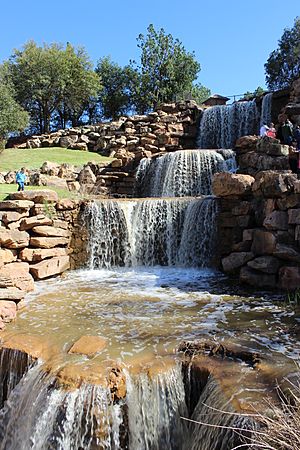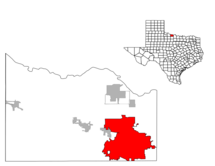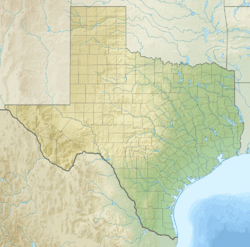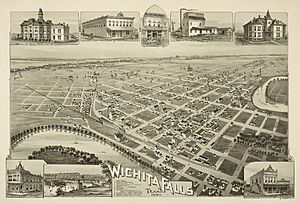Wichita Falls, Texas facts for kids
Quick facts for kids
Wichita Falls, Texas
|
||
|---|---|---|

Man-made replacement of the original waterfall in Lucy Park
|
||
|
||

Location in the state of Texas
|
||
| Country | ||
| State | ||
| County | Wichita | |
| Government | ||
| • Type | Council–manager | |
| Area | ||
| • City | 72.03 sq mi (186.57 km2) | |
| • Land | 72.01 sq mi (186.51 km2) | |
| • Water | 0.02 sq mi (0.06 km2) | |
| Elevation | 951 ft (290 m) | |
| Population
(2020)
|
||
| • City | 102,316 | |
| • Rank | US: 315th | |
| • Density | 1,420.46/sq mi (548.405/km2) | |
| • Urban | 99,437 (US: 319th) | |
| • Metro | 151,306 (US: 286th) | |
| Time zone | UTC−6 (CST) | |
| • Summer (DST) | UTC−5 (CDT) | |
| ZIP codes |
76301-11
|
|
| Area code(s) | 940 | |
| FIPS code | 48-79000 | |
| GNIS feature ID | 2412261 | |
| Website | City of Wichita Falls | |
Wichita Falls is a city in Texas, United States. It is the main city of the Wichita Falls area. This area includes Archer, Clay, and Wichita Counties. In 2020, about 102,316 people lived here. This makes it the 43rd largest city in Texas.
The city got its name in 1876 from a waterfall on the Wichita River. Sadly, this waterfall was destroyed by a flood in 1886.
Wichita Falls is also home to a famous building called the Newby-McMahon Building. People often call it the "world's littlest skyscraper". It was built in 1919 and was even featured in Ripley's Believe It or Not!.
Contents
History of Wichita Falls
Long ago, in the early 1800s, the Choctaw Native Americans lived in this area. They moved here from Mississippi after being displaced by a treaty signed in 1830–1831. A large Native American village was present where Wichita Falls is today, as late as 1841.
American settlers, mostly cattle ranchers, started arriving in the 1860s. The city was officially named Wichita Falls on September 27, 1876. This was because the Wichita River flowed through the area and had a waterfall. Just ten years later, in 1886, a big flood washed away the original waterfall.
After many years, people still wanted to see the famous falls. So, the city built a new, man-made waterfall next to the river in Lucy Park. This new waterfall is 54 feet (16 m) high. It pumps 3,500 gallons (13,249 liters) of water every minute. You can see it if you are driving south on Interstate 44.
On the day the city was named in 1876, land was sold at what is now Seventh and Ohio Streets. This spot is considered the birthplace of the city. The Fort Worth & Denver City Railway arrived in September 1882. That same year, Wichita Falls became the main city for Wichita County. The city grew west from the original train station. This area is now known as the Depot Square Historic District. It is a Texas Historic Landmark.
Two important business people, Joseph A. Kemp and Frank Kell, helped Wichita Falls grow a lot. They were involved in many businesses. These included food, flour, railroads, cattle, banking, and oil.
Downtown Wichita Falls used to be the main shopping area. But new shopping centers opened, like Parker Square in 1953 and Sikes Senter Mall in 1974. The city has been working to rebuild and improve the downtown area since 2010.
Wichita Falls was also a center for oil companies and related businesses. Oil refineries operated here for many years.
Tornadoes in Wichita Falls
Wichita Falls has been hit by strong tornadoes.
The 1964 Tornado
On April 3, 1964, a very powerful tornado hit the northern and northwestern parts of Wichita Falls. It also hit Sheppard Air Force Base. This tornado was called "Black Friday." It was the first very strong tornado to hit the area. Seven people died, and over 100 were hurt. The tornado destroyed about 225 homes and damaged 250 more. It caused about $15 million in damage. This tornado was rated F5, the highest level on the Fujita scale.
The 1979 Tornado
Another strong tornado hit the southern parts of Wichita Falls on April 10, 1979. This day is known as "Terrible Tuesday." It was part of a larger storm system that caused 30 tornadoes. Even though people had almost an hour's warning, 42 people died. Many of them were in their cars on their way home from work. About 1,800 people were injured. The tornado left 20,000 people without homes. It caused $400 million in damage. This was a U.S. record for tornado damage at the time.
Geography and Climate
Wichita Falls is about 15 miles (24 km) south of the Oklahoma border. It is 115 miles (185 km) northwest of Fort Worth and 140 miles (225 km) southwest of Oklahoma City. The city covers about 70.71 square miles (183.1 km2) of land. Only a tiny part, 0.02 square miles (0.05 km2), is water.
Wichita Falls has a humid subtropical climate. This means it has long, very hot, and humid summers. Winters are cool. The city often has some of the highest summer temperatures in the U.S. Temperatures can reach 100 °F (38 °C) as early as March or as late as October. On average, it hits 100 °F (38 °C) about 28 days a year. It gets to 90 °F (32 °C) or higher about 102 days a year.
The average temperature in January is 42.0 °F (5.6 °C). In July, it's 84.4 °F (29.1 °C). The coldest temperature ever recorded was −12 °F (−24 °C) in January 1947. The hottest was 117 °F (47 °C) in June 1980. Snowfall is not common, averaging about 4.1 inches (10 cm) per year. Most rain falls in early summer.
From 2010 to 2013, Wichita Falls had a long period of drought. In September 2011, it was the first Texas city to have 100 days of 100 °F (38 °C) or higher in one year. That summer was the hottest on record.
In May 2015, Wichita Falls had its wettest month ever. It received 17.00 inches (43.2 cm) of rain during the 2015 Texas–Oklahoma floods.
| Climate data for Wichita Falls, Texas (Wichita Falls Regional Airport), 1991–2020 normals, extremes 1923–present | |||||||||||||
|---|---|---|---|---|---|---|---|---|---|---|---|---|---|
| Month | Jan | Feb | Mar | Apr | May | Jun | Jul | Aug | Sep | Oct | Nov | Dec | Year |
| Record high °F (°C) | 87 (31) |
94 (34) |
100 (38) |
103 (39) |
110 (43) |
117 (47) |
115 (46) |
113 (45) |
112 (44) |
102 (39) |
91 (33) |
91 (33) |
117 (47) |
| Mean maximum °F (°C) | 76.9 (24.9) |
81.9 (27.7) |
88.2 (31.2) |
91.9 (33.3) |
97.4 (36.3) |
101.1 (38.4) |
105.5 (40.8) |
105.2 (40.7) |
100.4 (38.0) |
93.4 (34.1) |
82.8 (28.2) |
77.2 (25.1) |
107.3 (41.8) |
| Mean daily maximum °F (°C) | 54.7 (12.6) |
59.0 (15.0) |
67.9 (19.9) |
76.0 (24.4) |
83.9 (28.8) |
92.0 (33.3) |
97.2 (36.2) |
96.6 (35.9) |
88.3 (31.3) |
77.3 (25.2) |
65.2 (18.4) |
55.7 (13.2) |
76.2 (24.5) |
| Daily mean °F (°C) | 42.4 (5.8) |
46.3 (7.9) |
54.7 (12.6) |
62.8 (17.1) |
71.8 (22.1) |
80.1 (26.7) |
84.7 (29.3) |
84.1 (28.9) |
76.0 (24.4) |
64.6 (18.1) |
52.7 (11.5) |
43.7 (6.5) |
63.7 (17.6) |
| Mean daily minimum °F (°C) | 30.0 (−1.1) |
33.6 (0.9) |
41.6 (5.3) |
49.6 (9.8) |
59.7 (15.4) |
68.3 (20.2) |
72.2 (22.3) |
71.5 (21.9) |
63.8 (17.7) |
51.9 (11.1) |
40.2 (4.6) |
31.8 (−0.1) |
51.2 (10.7) |
| Mean minimum °F (°C) | 15.7 (−9.1) |
19.0 (−7.2) |
24.3 (−4.3) |
34.4 (1.3) |
44.9 (7.2) |
59.9 (15.5) |
65.3 (18.5) |
63.5 (17.5) |
50.7 (10.4) |
35.9 (2.2) |
24.8 (−4.0) |
17.3 (−8.2) |
11.8 (−11.2) |
| Record low °F (°C) | −12 (−24) |
−8 (−22) |
6 (−14) |
24 (−4) |
35 (2) |
50 (10) |
54 (12) |
53 (12) |
38 (3) |
21 (−6) |
14 (−10) |
−7 (−22) |
−12 (−24) |
| Average precipitation inches (mm) | 1.20 (30) |
1.40 (36) |
2.02 (51) |
2.50 (64) |
3.81 (97) |
3.35 (85) |
2.02 (51) |
2.53 (64) |
2.99 (76) |
2.88 (73) |
1.63 (41) |
1.56 (40) |
27.89 (708) |
| Average snowfall inches (cm) | 0.7 (1.8) |
1.1 (2.8) |
0.2 (0.51) |
0.0 (0.0) |
0.0 (0.0) |
0.0 (0.0) |
0.0 (0.0) |
0.0 (0.0) |
0.0 (0.0) |
0.0 (0.0) |
0.3 (0.76) |
0.8 (2.0) |
3.1 (7.87) |
| Average precipitation days (≥ 0.01 in) | 4.6 | 4.9 | 6.5 | 6.6 | 9.1 | 7.3 | 5.2 | 6.0 | 6.3 | 6.9 | 5.2 | 4.5 | 73.1 |
| Average snowy days (≥ 0.1 in) | 0.3 | 0.5 | 0.1 | 0.0 | 0.0 | 0.0 | 0.0 | 0.0 | 0.0 | 0.0 | 0.2 | 0.5 | 1.6 |
| Source 1: NOAA | |||||||||||||
| Source 2: National Weather Service | |||||||||||||
People of Wichita Falls
| Historical population | |||
|---|---|---|---|
| Census | Pop. | %± | |
| 1890 | 1,978 | — | |
| 1900 | 2,480 | 25.4% | |
| 1910 | 8,200 | 230.6% | |
| 1920 | 40,079 | 388.8% | |
| 1930 | 43,690 | 9.0% | |
| 1940 | 45,112 | 3.3% | |
| 1950 | 68,042 | 50.8% | |
| 1960 | 101,724 | 49.5% | |
| 1970 | 96,265 | −5.4% | |
| 1980 | 94,201 | −2.1% | |
| 1990 | 96,259 | 2.2% | |
| 2000 | 104,197 | 8.2% | |
| 2010 | 104,553 | 0.3% | |
| 2020 | 102,316 | −2.1% | |
| U.S. Decennial Census Texas Almanac: 1850–2000 |
|||
In 2020, Wichita Falls had a population of 102,316 people.
The city is made up of people from many different backgrounds:
- About 56.4% of people were White (not Hispanic or Latino).
- About 12.5% were Black or African American.
- About 2.4% were Asian.
- About 0.7% were Native American.
- About 4.7% were from two or more races.
- About 22.6% of the population was Hispanic or Latino (they can be of any race).
The average age in Wichita Falls was about 34.4 years old. About 22.9% of the people were under 18. About 14.9% were 65 or older.
The average income for a household was about $56,091. For families, it was about $71,975. About 15.2% of the people in Wichita Falls lived below the poverty line.
Economy and Jobs

Wichita Falls has many important employers. These businesses and organizations provide many jobs for the people living in the city.
Here are some of the top employers:
- Sheppard Air Force Base: This is a large military base and the biggest employer.
- Wichita Falls Independent School District: This is the public school system.
- United Regional Health Care System: A major hospital and healthcare provider.
- Midwestern State University: A local university.
- City of Wichita Falls: The city government itself.
- Arconic: A company that makes advanced materials.
- Walmart: There are three Walmart stores in the city.
- North Texas State Hospital: A state hospital campus.
- Vitro: A company involved in glass manufacturing.
- Texas Department of Criminal Justice James V. Allred Unit: A state prison.
Media
Wichita Falls has its own media market. This also includes the nearby city of Lawton, Oklahoma. This means that TV and radio stations here serve both areas.
Newspapers
- Times Record News: This is a daily newspaper.
- Falls News Journal: This is also a daily newspaper.
Television Stations
- KFDX-TV (channel 3): This station shows NBC programs and The CW on a digital subchannel.
- KAUZ-TV (channel 6): This station shows CBS programs.
- KSWO-TV (channel 7): This station shows ABC programs and Telemundo on a digital subchannel.
- KJTL (channel 18): This station shows Fox programs.
- KJBO-LD (channel 35): This station shows MyNetworkTV programs.
You can also watch PBS programs from KERA-TV (from Dallas–Fort Worth) through a local translator station.
Radio Stations
Wichita Falls has many radio stations that play different types of music and news:
- KWFS (1290 AM): Plays news and talk radio.
- KMCU (88.7 FM): Plays National Public Radio programs.
- KMOC (89.5 FM): Plays Contemporary Christian music.
- KZKL (90.5 FM): Plays Contemporary Christian music.
- KNIN (92.9 FM): Plays CHR (current popular songs).
- KOLI (94.9 FM): Plays Modern Country music.
- KTWF (95.5 FM): Plays Classic hits (popular songs from past decades).
- KXXN (97.5 FM): Plays Classic Country music.
- KLUR (99.9 FM): Plays Country music.
- KWFB (100.9 FM): Plays Adult hits (popular songs for adults).
- KWFS-FM (102.3 FM): Plays Modern Country music.
- KQXC (103.9 FM): Plays Rhythmic CHR (hip-hop and R&B).
- KYYI (104.7 FM): Plays Classic rock music.
- KBZS (106.3 FM): Plays Active rock music.
Sports and Fun Things to Do
Recreation
Lucy Park
Lucy Park is a large park, about 170 acres (69 ha) in size. It has a log cabin, a duck pond, a swimming pool, and a playground. You can also find a frisbee golf course and picnic areas there. The park has paved paths perfect for walking, running, biking, or rollerskating. There's even a river walk that leads to the man-made waterfall. This waterfall was built because the original one was destroyed by a flood. People kept asking to see the "Wichita Falls," so the city made a new one!
Lucy Park is just one of 37 parks in the city. These parks range from small neighborhood spots to the huge 258-acre (104 ha) Weeks Park. Weeks Park has an 18-hole golf course called the Champions Course. There's also a dog park at Lake Wichita Park and a skatepark next to the city's softball fields. If you like off-road biking or hiking, there are unpaved trails too.
Hotter'N Hell Hundred
Wichita Falls is famous for the annual Hotter'N Hell Hundred. This is the biggest single-day century bicycle ride in the United States. It's also one of the largest bike races in the world! The race started in 1982 to celebrate the city's 100th birthday. It takes place over a weekend in August, with many events for people to join.
Sports Teams
Wichita Falls has been home to some sports teams over the years.
- The Wichita Falls Nighthawks were an indoor football team. They played in the Indoor Football League from 2014 to 2017.
- Other teams included the Wichita Falls Drillers (football), the Wichita Falls Texans (basketball), Wichita Falls Fever (soccer), the Wichita Falls Spudders (baseball), and the Wichita Falls Wildcats (hockey).
The Professional Wrestling Hall of Fame moved to Wichita Falls in November 2015.
Education and Learning
Schools for Kids
Public schools in Wichita Falls are managed by a few different school districts:
- Wichita Falls Independent School District
- City View Independent School District
- Burkburnett Independent School District
- Iowa Park Consolidated Independent School District
There are also private schools and home-schooling options. Many local elementary schools offer the Head Start program for young children before kindergarten.
Two schools in the Wichita Falls ISD offer special International Baccalaureate programs. Hirschi High School has the IB Diploma Programme. G.H. Kirby Junior High School has the Middle Years Programme. Other public high schools include Wichita Falls High School, S. H. Rider High School, and City View High School.
The first school in Wichita Falls was set up in 1879. The first public school was a log building in the 1880s. A school district was created in 1900, and the Texas Legislature officially approved the WFISD in 1908.
There is also a school for German children in the city called Deutsche Schule Sheppard (DSS).
Colleges and Universities
Wichita Falls is home to Midwestern State University. This is a four-year college that is part of the Texas Tech University System. It offers both bachelor's and master's degrees.
Vernon College is the local community college for Wichita County. It has a branch in Wichita Falls that offers two-year degrees and training programs.
Wayland Baptist University also has a branch here, offering bachelor's and master's degrees.
Getting Around Wichita Falls
Highways
Wichita Falls is where Interstate 44 begins in the west. Several other major roads, called U.S. Highways, pass through or lead to Wichita Falls. These include U.S. Routes 287, 277, 281, and 82. State Highway 240 ends here, and State Highway 79 runs through the city.
Wichita Falls has many miles of freeways for a city its size. This is because voters approved a plan in 1954 to build several expressway routes. The first part opened in 1958. Over the years, more freeway sections were added, connecting different parts of the city and leading to nearby towns like Henrietta, Jacksboro, Iowa Park, Electra, and Burkburnett. In 2001, a new elevated freeway was completed downtown, making it easier for cars to pass through.
Work has also been done to turn Kell Boulevard into a freeway for U.S. 82–277. This project started in 1967 and has been completed in stages.
Public Transportation
The city has a bus system called Falls Ride. Buses run every hour on seven different routes. On Sundays, there is only one route.
Greyhound Lines offers bus service to other cities from the Wichita Falls Travel Center downtown. Skylark Van Service provides shuttle rides to and from Dallas-Fort Worth International Airport several times a day.
The Wichita Falls Municipal Airport has flights to the Dallas/Fort Worth International Airport twice a day through American Eagle. Smaller, private planes can use the Kickapoo Downtown Airport and the Wichita Valley Airport.
There are also plans to bring Amtrak train service back to Wichita Falls. The city last had passenger train service in 1967.
Landmarks to See
-
The Newby-McMahon Building, finished in 1919. It's also known as the "Worlds Littlest Skyscraper."
Famous People from Wichita Falls
Many notable people have connections to Wichita Falls:
- Greg Abbott: The current Governor of Texas was born here.
- Chase Anderson: A professional baseball player.
- JT Barrett: A quarterback who played for Ohio State University.
- Renick Bell: A musician known for live coding.
- Lindy Berry: A great quarterback for the Edmonton Eskimos.
- Ryan Brasier: Another professional baseball player.
- John Bundy: A magician.
- Frank Kell Cahoon: An oilman and Texas politician.
- Raymond Carroll: A statistician at Texas A&M University.
- Greyson Chance: A singer-songwriter and pianist.
- Don Cherry: A pop singer and amateur golfer.
- Bert Clark: A football coach.
- Phyllis Coates: A film and television actress.
- William C. Conner: A federal judge.
- Hunter Dozier: A professional baseball player for the Kansas City Royals.
- Nic Endo: A singer for the band Atari Teenage Riot.
- "Cowboy" Morgan Evans: A rodeo champion.
- Marcus Foster: A basketball player.
- Thomas W. Fowler: A World War II hero who received the Medal of Honor.
- Sally Gary: A speaker and author.
- Roberta Haynes: An actress.
- Eddie Hill: A drag racer.
- Frank N. Ikard: A former U.S. representative.
- Robert Jeffress: A Baptist clergyman.
- Matt and Bubba Kadane: Members of the band Bedhead (band).
- Neel Kearby: A World War II flying ace and Medal of Honor recipient.
- Christian Leave: An American singer-songwriter.
- Keith Lee: A professional wrestler.
- Khari Long: A professional football player.
- Rosie Manning: A professional football player.
- Markelle Martin: A professional football player.
- Phil McGraw: The host of a popular advice television show.
- Larry McMurtry: A famous author.
- Richard M. Mullane: An astronaut and author.
- Ed Neal: A professional football player.
- David Nelson: A professional football player.
- Shaunie O'Neal: An American television personality.
- Edward Opp: A photojournalist.
- Graham B. Purcell, Jr.: A former U.S. representative.
- Jaret Reddick: The lead singer for the band Bowling for Soup.
- Frances Reid: A soap opera actress.
- Mark Rippetoe: A physical trainer and author.
- Herbert Rogers: A classical pianist.
- Lloyd Ruby: A race car driver.
- Bernard Scott: A professional football player.
- Danielle Smith: A professional football player and CEO.
- Frank Lee Sprague: A composer and musician.
- Keith Stegall: A country music artist and producer.
- David Swinford: A Texas state legislator.
- Rex Tillerson: The former United States Secretary of State and ExxonMobil CEO.
- John Tower: A U.S. Senator.
- Tommy Tune: A famous actor, dancer, choreographer, and producer.
- Nathan Vasher: A professional football player.
- Julian Elvis Ward Jr..
- Ronnie Williams: A professional football player.
- Dave Willis: A voice actor and screenwriter.
See also
 In Spanish: Wichita Falls para niños
In Spanish: Wichita Falls para niños













